1993 CADILLAC FLEETWOOD brake fluid
[x] Cancel search: brake fluidPage 210 of 386
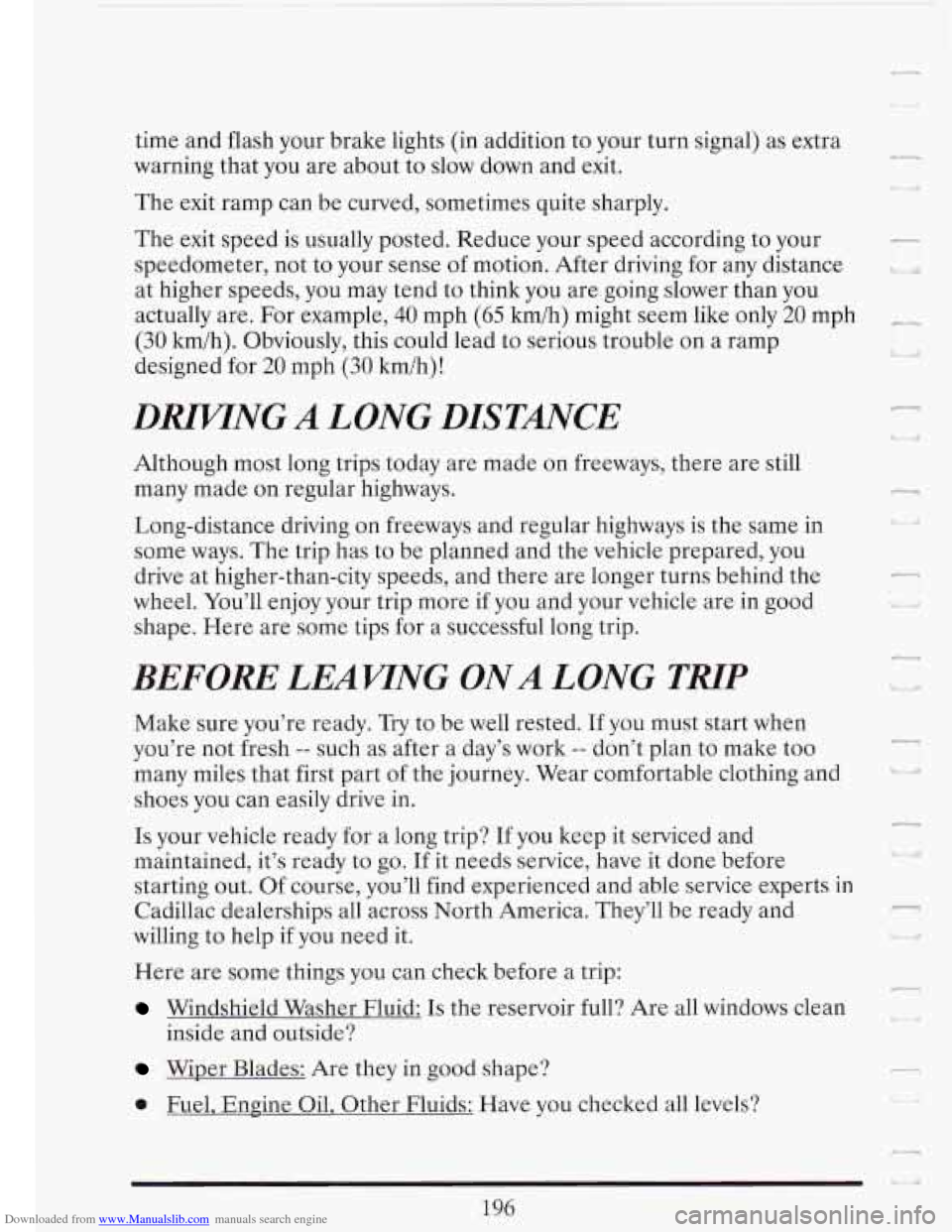
Downloaded from www.Manualslib.com manuals search engine time and flash your brake lights (in addition to your turn signal) as extra
warning that you are about to slow down and exit.
The exit ramp can be curved, sometimes quite sharply.
-.
U t I! The exit speed is usually posted. Reduce your speed according to your
speedometer, not to your sense
of motion. After driving for any distance
at higher speeds, you may tend to think you are going slower than you
actually are. For example,
40 mph (65 h/h) might seem like only 20 mph c_?
(30 km/h). Obviously, this could lead to serious trouble on a ramp
designed for
20 mph (30 kmih)!
I
L/
DRIVTNG A LONG DISTANCE
Although most long trips today are made on freeways, there are still
many made on regular highways.
Long-distance driving on freeways and regular highways is the same in
some ways. The trip has
to be planned and the vehicle prepared, you
drive at higher-than-city speeds, and there are longer turns behind the
wheel. You’ll enjoy your trip more if you and your vehicle are in good
shape. Here are some tips for a successful long trip.
BEFORE LEAWNG ONA LONG TRlP
Make sure you’re ready. Try to be well rested. If you must start when
you’re not fresh
-- such as after a day’s work -- don’t plan to make too
many miles that first part of the journey. Wear comfortable clothing and
shoes you can easily drive in.
.3
I
F i ! u
Is your vehicle ready for a long trip? If you keep it serviced and
maintained, it’s ready to
go. If it needs service, have it done before
starting out. Of course, you’ll find experienced and able service experts in
Cadillac dealerships all across North America. They’ll be ready and
7
willing to help if you need it. -1
Here are some things you can check before a trip:
Windshield Washer Fluid: Is the reservoir full? Are all windows clean
inside and outside?
Wiper Blades: Are they in good shape?
0 Fuel, Engine Oil, Other Fluids: Have you checked all levels?
Page 213 of 386
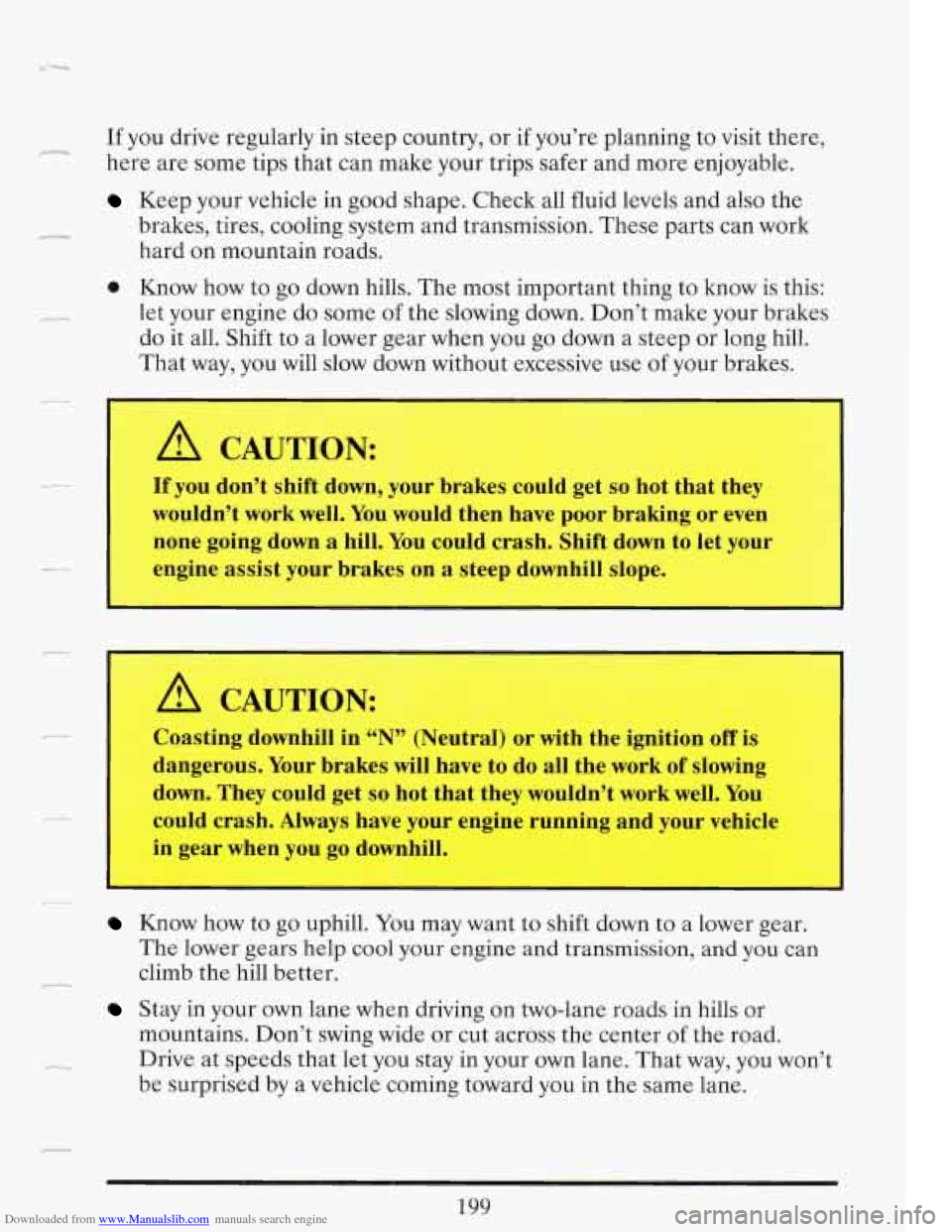
Downloaded from www.Manualslib.com manuals search engine c If you drive regularly in steep country, or if you’re planning to visit there,
here are some tips that can make your trips safer and more enjoyable.
Keep your vehicle in good shape. Check all fluid levels and also the
brakes, tires, cooling system and transmission. These parts can work
hard on mountain roads.
0 Know how to go down hills. The most important thing to know is this:
let your engine do some
of the slowing down. Don’t make your brakes
do it all. Shift to a lower gear when you go down a steep or long hill.
That way, you will slow down without excessive use
of your brakes.
I_ I
I
I A CAUTION:
If you don’t shift down, your brakes could get so hot that they
wouldn’t work well. You would then have poor braking or even
none going down a hill. You could crash. Shift down to let your
engine assist your brakes on
a steep downhill slope.
I
A CAUTION:
- I Coasting downhill in “N” (Neutral) or with the ignition off is
dangerous. Your brakes
will have to do all the work of slowing
down. They could get
so hot that they wouldn’t work well. You
could crash. Always have your engine running and your vehicle
in gear when you go downhill.
I
Know how to go uphill. You may want to shift down to a lower gear.
The lower gears help cool your engine and transmission, and you can
e.-- climb the hill better.
,-
Stay in your own lane when driving on two-lane roads in hills or
mountains. Don’t swing wide or cut across the center of the road.
Drive at speeds that let you stay in your own lane. That way, you won’t
be surprised by a vehicle coming toward you in the same lane.
Page 229 of 386
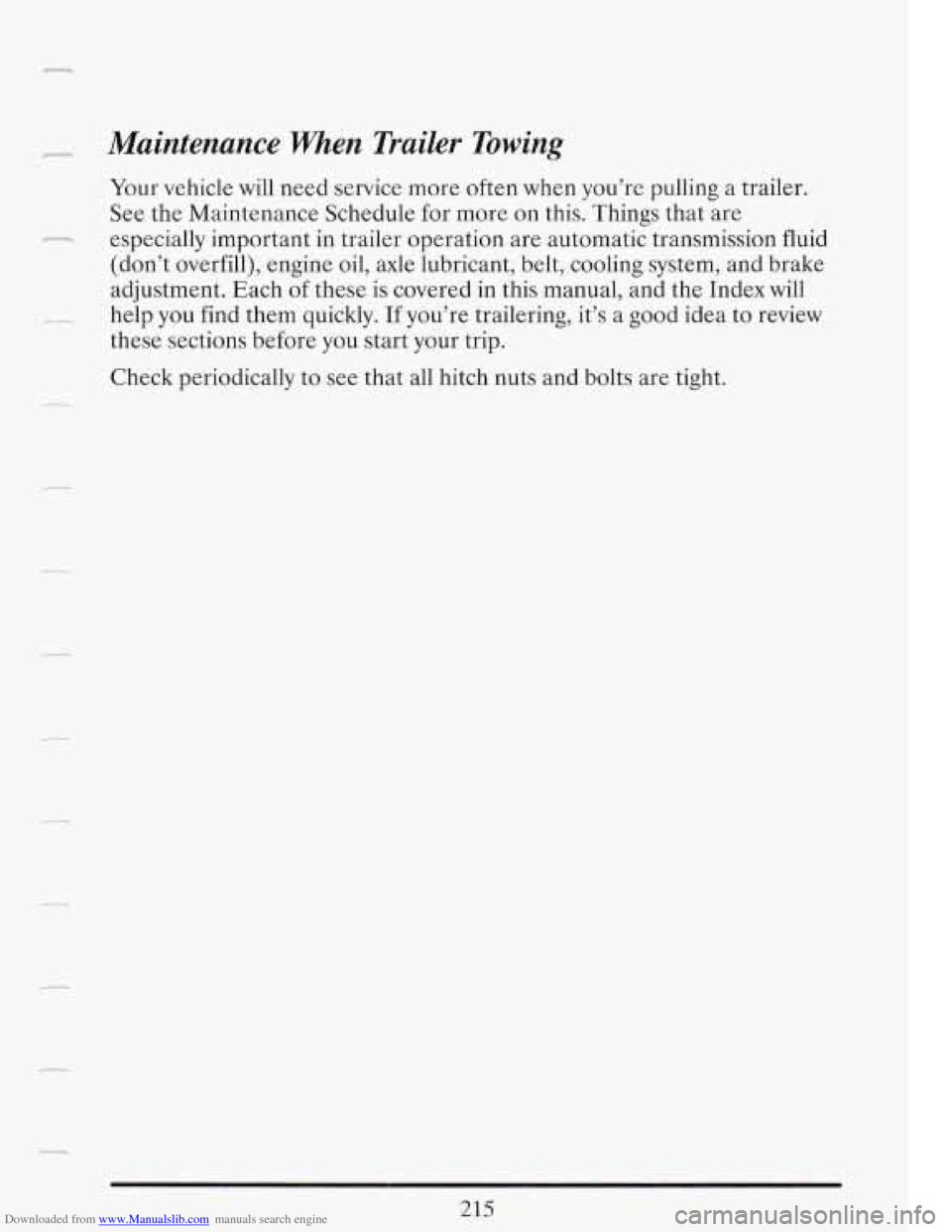
Downloaded from www.Manualslib.com manuals search engine - Maintenance when Trailer Towing
Your vehicle will need service more often when you’re pulling a trailer.
See the Maintenance Schedule for more on this. Things that are
(don’t overfill), engine oil, axle lubricant, belt, cooling system, and brake
adjustment. Each
of these is covered in this manual, and the Index will
__- help you find them quickly. If you’re trailering, it’s a good idea to review
these sections before you start your trip.
Check periodically to see that all hitch nuts and bolts are tight.
rc-.- especially important in trailer operation are automatic transmission fluid
215
Page 272 of 386
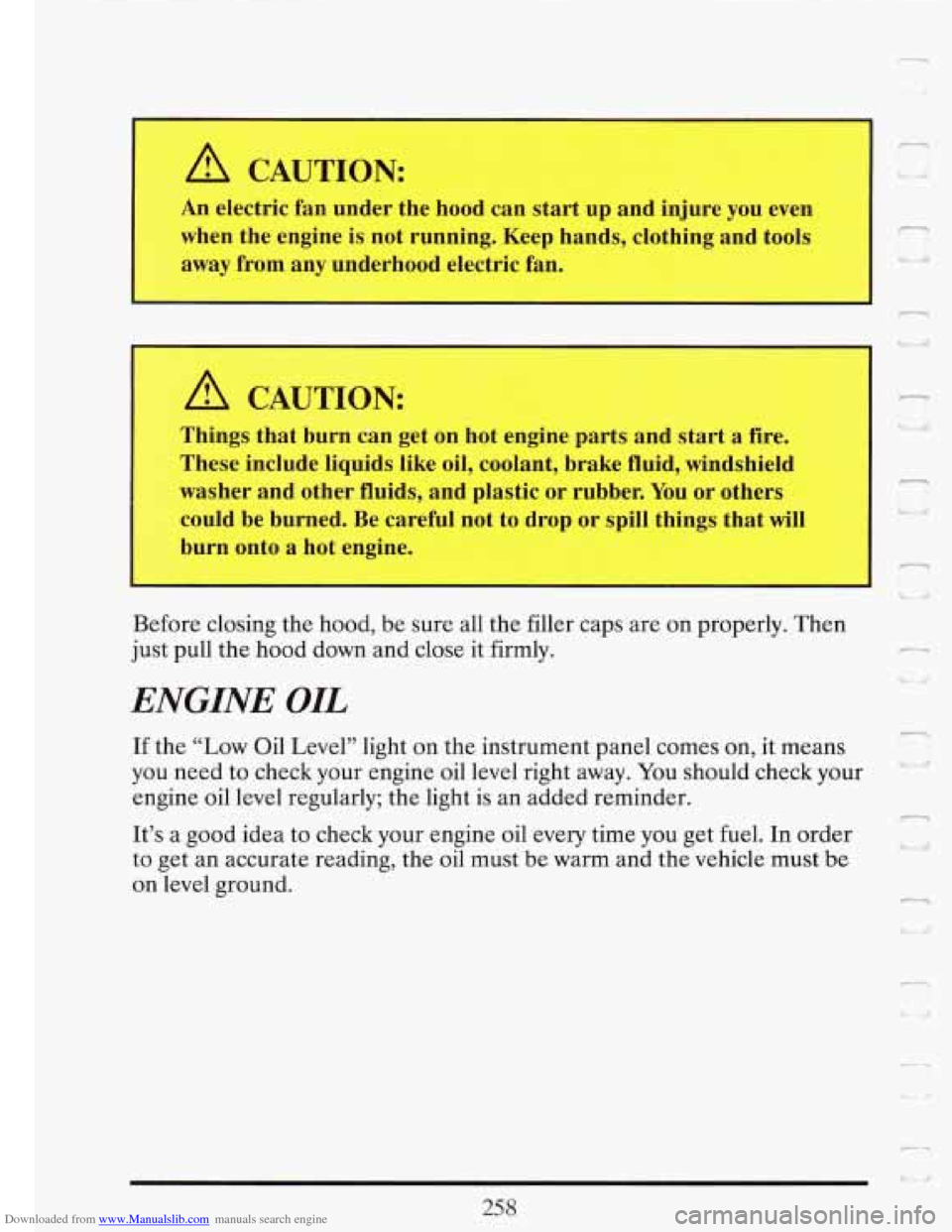
Downloaded from www.Manualslib.com manuals search engine A CAUTION:
An electric fan under the hood can start up and injure you even
when the engine is not running. Keep hands, clothing and tools
away from any underhood electric fan.
A CAUTION:
Things that burn can get on hot engine parts and start a fire.
These include liquids like oil, coolant, brake fluid, windshield
washer and other fluids, and plastic or rubber.
You or others
could be burned. Be careful not to drop or spill things that will
burn onto
a hot engine.
I
Before closing the hood, be sure all the filler caps are on properly. Then
just pull the hood down and close it firmly.
ENGINE OIL
If the “Low Oil Level” light on the instrument panel comes on, it means
you need to check your engine oil level right away. You should check your
engine oil
level regularly; the light is an added reminder.
It’s a good idea to check your engine oil every time you get
fuel. In order
to get an accurate reading, the oil must be warm and the vehicle must be
on level ground. c1
u
Page 281 of 386
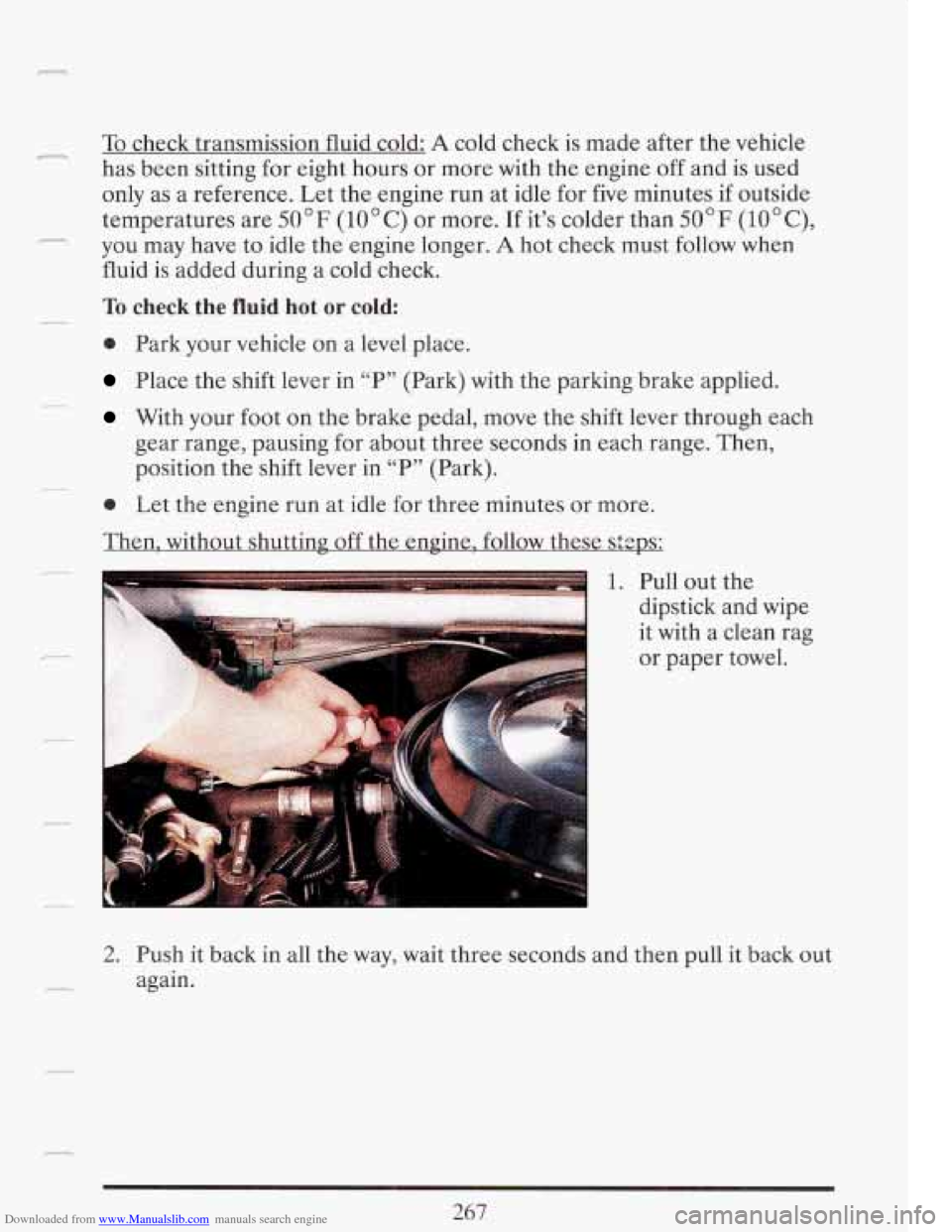
Downloaded from www.Manualslib.com manuals search engine n To check transmission fluid cold: A cold check is made afte.r the vehicle
has been sitting for eight hours or more with the engine off and is used
only as a reference. Let the engine run at idle for five minutes if outside
temperatures are
50°F (10°C) or more. If it’s colder than 50°F (lO°C),
you may have to idle the engine longer. A hot check must follow when
fluid is added during a cold check. .-
To check the fluid hot or cold:
0 Park your vehicle on a level place.
Place the shift lever in “P” (Park) with the parking brake applied.
__
With your foot on the brake pedal, move the shift lever through each
gear range, pausing for about three seconds in each range. Then,
position the shift lever in
“P” (Park). ~
0 Let the engine run at idle for three minutes or more.
Then. without shutting
off the engine! follow these skgs:
2. Push it back in all the way, wait three seconds and then pull it back out
again.
267
Page 289 of 386
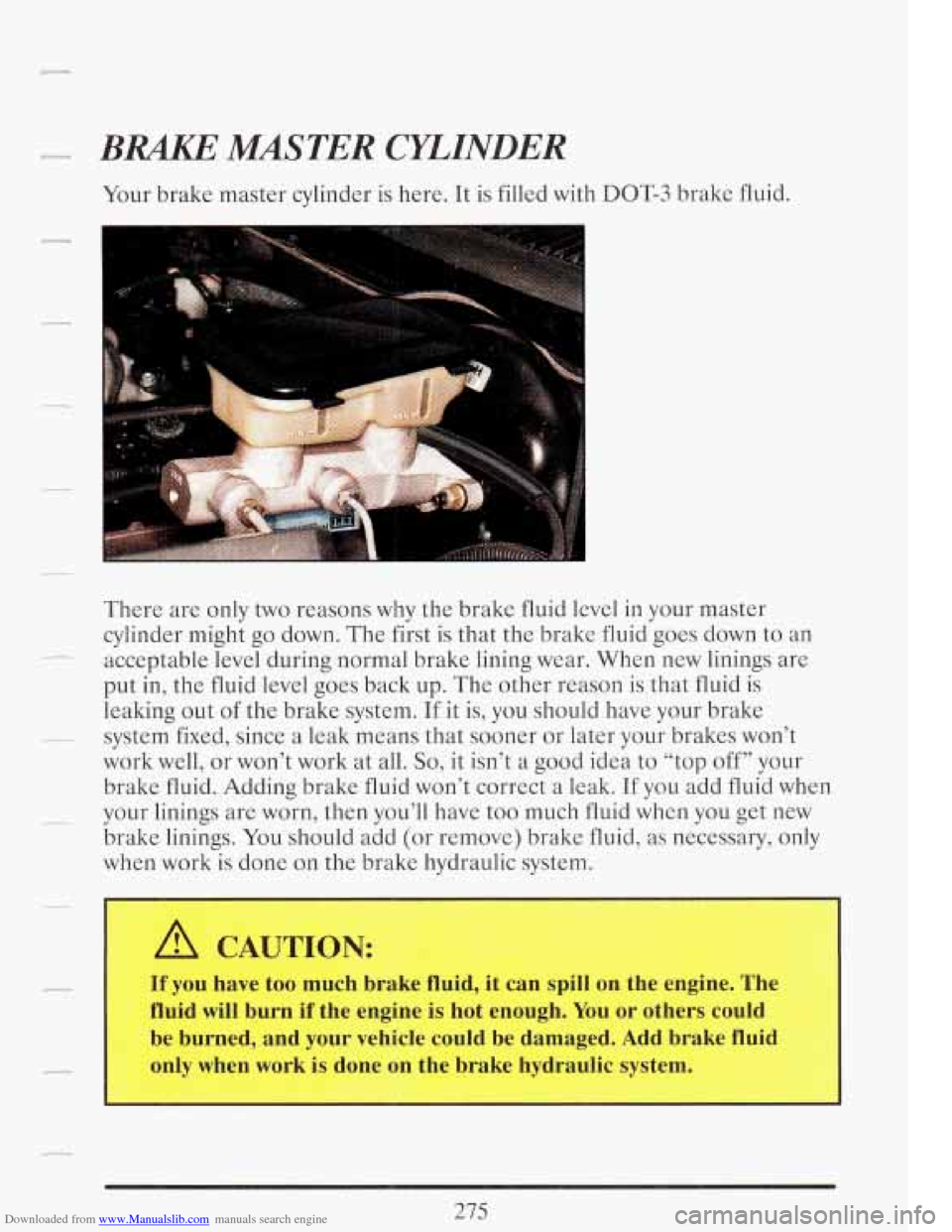
Downloaded from www.Manualslib.com manuals search engine There are only two reasons why the brake fluid level in your master
cylinder might go down. The first is that the brake fluid goes down to an
put in, the fluid
level goes back up. The other reason is that fluid is
leaking out
of the brake system. If it is, you should have your brake
work well, or won’t work at all.
So, it isn’t a good idea to “top off” your
brake fluid. Adding brake fluid won’t correct
a leak. If you add fluid when
__ your linings are worn, then you’ll have too much fluid when you get new
brake linings. You should add (or remove) brake fluid,
as necessary, only
when work is done on the brake hydraulic system.
-- acceptable level during normal brake lining wear. When new linings are
~ system fixed, since a leak means that sooner or later your brakes won’t
A CAUTION:
If you have too much brake fluid, it can spill on the engine. The
fluid
will burn if the engine is hot enough. You or others could
be burned, and your vehicle could be damaged. Add brake fluid
only when work is done on the brake hydraulic system.
275
Page 290 of 386
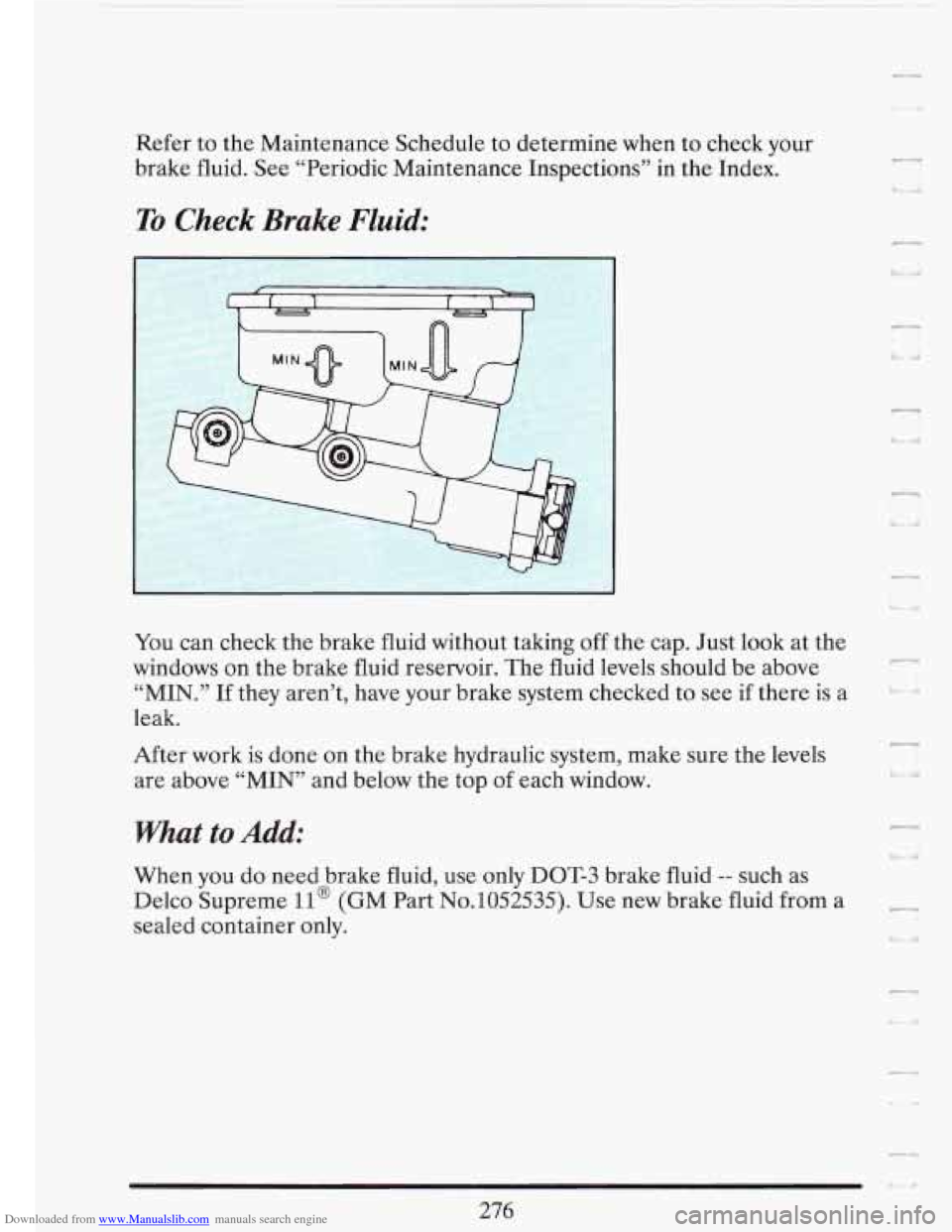
Downloaded from www.Manualslib.com manuals search engine -
L.. i
Refer to the Maintenance Schedule to determine when to check your
brake fluid. See “Periodic Maintenance Inspections” in the Index.
To Check Brake Fluid:
I
You can check the brake fluid without taking off the cap. Just look at the
windows on the brake fluid reservoir. The fluid levels should be above
“MIN.” If they aren’t, have your brake system checked to see if there is a %
leak.
7-
After work is done on the brake hydraulic system, make sure the levels
are above “MIN” and below the top
of each window.
What to Add:
When you do need brake fluid, use only DOT-3 brake fluid -- such as
Delco Supreme
11 @ (GM Part No. 1052535). Use new brake fluid from a
sealed container only.
276
L1
Page 324 of 386
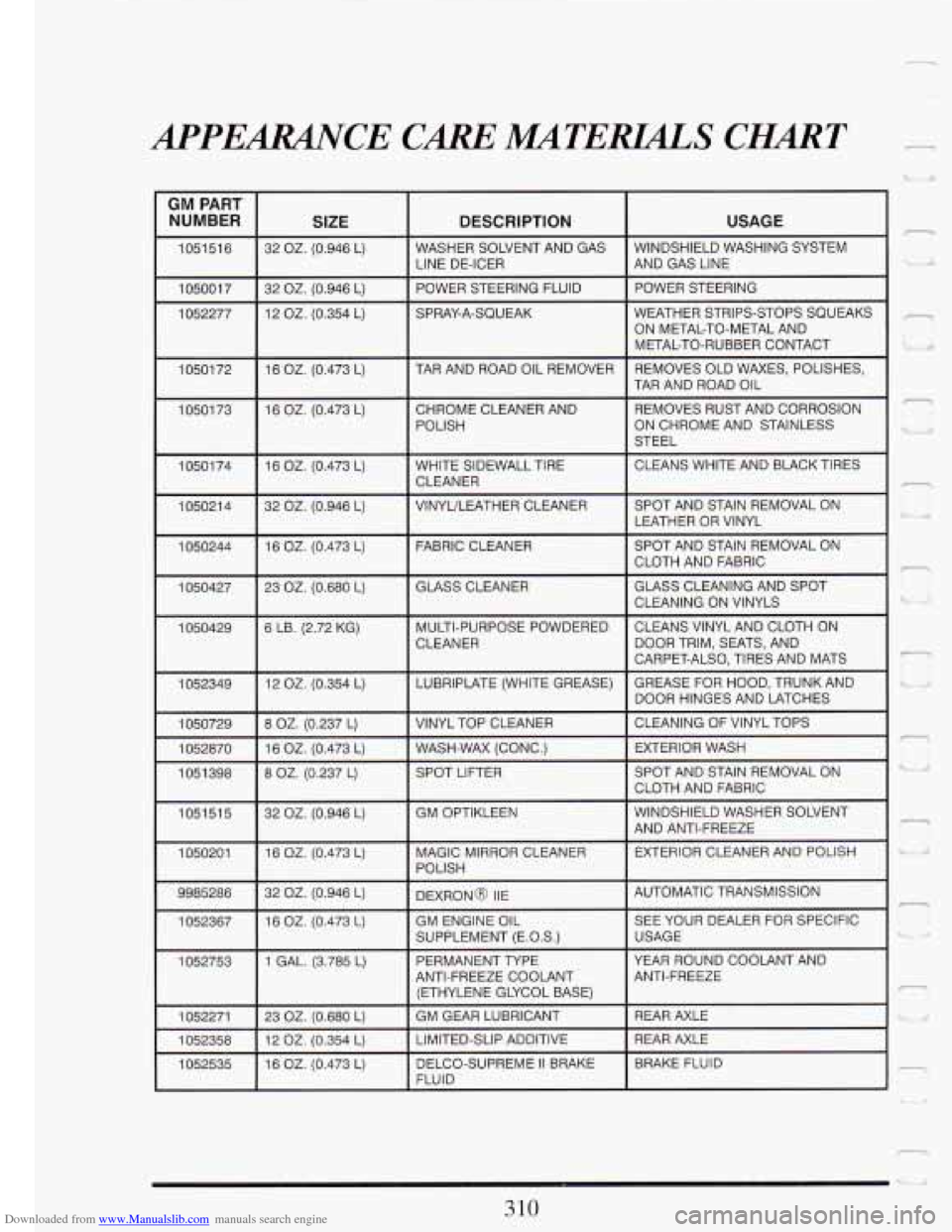
Downloaded from www.Manualslib.com manuals search engine APPEMCE CAREM!XTERUL,S CHMT
GM PART
NUMBER SIZE DESCRIPTION
1051516 32 OZ. (0.946 L) WASHER SOLVENT AND GAS
LINE DE-ICER
105001 7 32
OZ. (0.946 L) POWER STEERING FLUID
12
OZ. (0.354 L) SPRAY-A-SQUEAK
10501 72 16
OZ. (0.473 L) TAR AND ROAD OIL REMOVER
I 10501 73 I 16 OZ. (0.473 L) I CHROME CLEANER AND
I
1050174 16 OZ. (0.473 L) WHITE SIDEWALL TIRE
CLEANER
VINYL/LEATHER CLEANER
MULTI-PURPOSE POWDERED
CLEANER
1052870 16 OZ.
(0.473
L) WASH-WAX (CONC.)
8
OZ. (0.237 L) SPOT LIFTER
1051 51
5 32 OZ. (0.946 L) GM OPTIKLEEN
1050201 16
OZ. (0.473 L) MAGIC MIRROR CLEANER
POLISH
I 9985286 I 32 OZ. (0.946 L) I DEXRONB IIE
I 1052367
1052753
1052271 16
OZ. (0.473 L) GM
ENGINE OIL
SUPPLEMENT (E.O.S.)
1 GAL. (3.785 L) PERMANENT TYPE
ANTI-FREEZE COOLANT
(ETHYLENE GLYCOL BASE)
23
OZ. (0.680 L)
DELCO-SUPREME
II BRAKE
16 OZ. (0.473 L) LIMITED-SLIP ADDITIVE
12 OZ. (0.354 L) GM
GEAR LUBRICANT
FLUID
USAGE
WINDSHIELD WASHING SYSTEM
AND GAS LINE
POWER STEERING
WEATHER STRIPS-STOPS SQUEAKS
ON METAL-TO-METAL AND
METAL-TO-RUBBER CONTACT
REMOVES OLD WAXES, POLISHES,
TAR AND ROAD OIL
REMOVES RUST AND CORROSION
ON CHROME AND STAINLESS
STEEL
CLEANS WHITE AND BLACK TIRES
SPOT AND STAIN REMOVAL ON
LEATHER
OR VINYL
SPOT AND STAIN REMOVAL ON
CLOTH AND FABRIC
GLASS CLEANING AND SPOT
CLEANING ON VINYLS
CLEANS VINYL AND CLOTH ON
DOOR TRIM, SEATS, AND
CARPET-ALSO, TIRES AND MATS
GREASE FOR HOOD, TRUNK AND
DOOR HINGES AND LATCHES
CLEANING OF VINYL TOPS
EXTERIOR WASH
SPOT AND STAIN REMOVAL ON
CLOTH AND FABRIC
WINDSHIELD WASHER SOLVENT
AND ANTI-FREEZE
EXTERIOR CLEANER AND POLISH
AUTOMATIC TRANSMISSION SEE YOUR DEALER FOR SPECIFIC
USAGE
YEAR ROUND COOLANT AND
ANTI-FREEZE
REAR AXLE
REAR AXLE
BRAKE FLUID
.-
JI
7
'I-i I I
J ~
.-
310